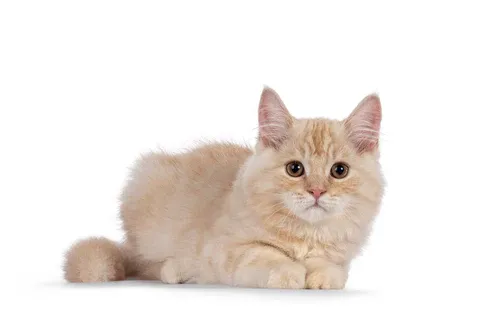Have you ever spotted a cat that resembles a fluffy bowling ball with legs, completely lacking a tail? That’s the enchanting Cymric cat, also known as the long-haired Manx. These distinctive felines captivate with their playful energy, dog-like devotion, and adventurous spirit, making them an ideal choice for families seeking a loyal, unique companion. Originating from tales of genetic quirks on the Isle of Man, Cymric Cats blend rarity with charm, drawing in cat enthusiasts worldwide.
Cymric Cat Appearance
The Cymric cat’s most iconic feature is its tailless or stubby tail, a hallmark shared with its Manx relatives. According to veterinary experts at Vetstreet, these cats may have no tailbone (rumpies), a short stump with a few vertebrae (stumpies), or rarely a longer tail (longies) that’s still shorter than average. This mutation gives them a compact, rounded silhouette that’s both endearing and sturdy.
Beyond the tail, Cymric cats boast a robust, rounded body with a broad chest, short legs, and large, expressive round eyes that exude sweetness. Their head is round with prominent cheeks, adding to their plush, teddy bear-like look. What truly sets the Cymric apart from the short-haired Manx is its luxurious, double-layered coat—long, thick, and silky, available in countless colors and patterns like tabby, solid, or tortoiseshell.
 Cymric Cat
Cymric Cat
Maintaining this glorious coat requires moderate grooming: brush two to three times weekly to remove loose fur and prevent mats, ramping up during seasonal sheds in spring and fall. Regular care keeps their coat gleaming and reduces hairballs, ensuring your Cymric stays comfortable and healthy. Drawing from experiences of long-time breeders, consistent brushing also strengthens the bond between you and your pet.
Cymric Cat Personality
Cymric cats shine with their sociable, intelligent nature, often described as dog-like in loyalty. As noted by The International Cat Association (TICA), they excel at learning tricks like fetch and navigating obstacles, thanks to their agile paws and powerful jumping ability. Don’t be surprised if your Cymric opens cabinets or doors out of sheer curiosity—these cats are natural explorers.
Far from aloof, Cymrics form deep attachments to their families, including kids and other pets. They’re playful yet laid-back, thriving in active households. Like many outdoor cat breeds, they love leaping and climbing, but their indoor adaptability makes them versatile. A standout trait is their fascination with water—many splash in bowls, bat at faucets, or lounge near ponds. Supervised water play can engage their inquisitive minds, as shared by pet parents on forums like Petfinder.
For owners of fancy cat breeds, the Cymric’s blend of smarts and affection stands out. They’re not overly demanding but crave interaction, making them perfect for puzzle toys or interactive sessions that mimic hunting.
 PrettyLitter cat litter bag on display with blue geometric shapes in the background
PrettyLitter cat litter bag on display with blue geometric shapes in the background
The Cymric and Manx Cat History
To appreciate the Cymric cat fully, delve into its roots alongside the Manx. Both hail from the Isle of Man, where the tailless trait emerged as a spontaneous genetic mutation, possibly introduced by ancient traders like Phoenicians or Vikings, per TICA records. Over generations, this dominant mutation spread, defining the breed.
While Manx cats are short-haired, long-haired offspring were historically called “longies” or simply long-haired Manx. Debate persists: Are Cymrics a separate breed? Some trace their formal recognition to the 1960s, when Canadian breeders like Blair Wright and Leslie Falteisek selectively bred for the long coat, naming it “Cymric” (Welsh for Wales) in the 1970s to honor Celtic ties.
Unlike some worst cat breeds with health woes, the tailless gene brings caveats like spinal risks (Manx Syndrome), so reputable breeders screen for issues. Vets recommend annual check-ups for rumpies to monitor mobility.
Petfinder and CatTime affirm Cymrics’ resilience, with lifespans of 12-15 years when well-cared for. Compared to relatives like the flamepoint Siamese, Cymrics offer a sturdier build suited to playful lifestyles.
Caring for Your Cymric Cat
Beyond basics, Cymric care emphasizes joint health due to their unique anatomy. Provide ramps for high spots, a high-quality diet rich in omega-3s for coat and mobility, and litter like PrettyLitter for odor control and health insights. Early socialization ensures their friendly traits flourish.
In summary, the Cymric cat embodies uniqueness with its tailless charm, loving personality, and rich history. Whether debating its Manx ties or marveling at its fluff, this breed rewards dedicated owners with endless joy. Consult a vet for tailored advice, and explore more on fancy cat breeds to find your perfect match. Start your Cymric adventure today!
